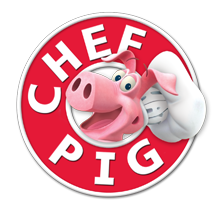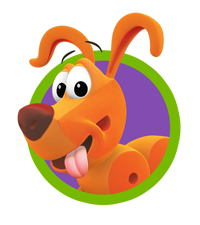
Guided Learning
Things to do with your children before watching WordWorld
Preview the episode beforehand:
- Identify WordFriends™, WordThings™, other vocabulary, story problem(s) and solution(s), and social skills covered in the episode.
- Identify places where it makes sense to stop and ask children for predictions.
- Post pictures of WordFriends around your space. Ask children to help you spell their names.

Things to do with your children while watching WordWorld
- Do a focused watch with your group:
- Before viewing, freeze the episode’s title page on screen and read the title. Ask your children to predict what will happen in the episode. Ask them which WordFriends or WordThings they may see.
- Help your children predict how the WordFriends will solve the problem in each episode. Ask the question, “What word do you think the WordFriends will need to build to solve the problem?” Facilitate a verbal brainstorm and write down their responses.
- While viewing, stop after several minutes (or at a pre-determined place in the story) and ask your children to check their predictions. Did they come true, or not? If the answer is no, what happened instead?
- Ask for additional predictions. Check these new predictions at the next pause.
- Continue to do this until the end of the episode, but no more than 3 times per episode.
- At the end of the episode, ask your children what lesson the WordFriends learned.
This line of questioning is one of the best ways to support your childrens’ comprehension. This procedure may be used while reading with your children as well. - Play “I Spy” – “Who can spot the letters/words in each segment?”
- Help your children identify the letters in the WordFriends (SHEEP, PIG, ANT, etc.) and WordThings (BARN, SCHOOL, BRIDGE, etc.) in each episode.
- Make a chart with the alphabet across the top. Tally how many times each letter appears in the episode. Allow children to do this if possible. This incorporates math concepts as well!
- Have fun! Encourage your children to sing and dance along to the music! Learn and sing the “Build a Word” song with your children. You can create your own dance moves, too!
- Watch with your children! During viewing, talk with your children about what’s happening on screen. Ask questions about what might happen next. These questions are good for supporting your children’s comprehension.
- Reinforce your children’s learning by spelling words as you refer to them. For example, “Here comes S-H-E-E-P – sheep”.
- Make connections between things that are happening in the show and your children’s world. For example, if the show focuses on the letter “O” and your children’s names includes the letter “O”, point it out.
The more you can tie in the learning that is taking place on screen with things that your children are familiar with, the better.
Things to do with your children after watching WordWorld
- Make connections between things that are happening in the show and your world. For example, if the show focuses on the letter “O,” point the letter out when you come across it in the classroom, hallway, kitchen or living room.
You may do the same with words from the episode, noticing them in books (see WordWorld eBooks: http://wordworld.com/ebook1), as well as in the environment.
The more you can tie together the learning that happens on screen with everyday life and students’ previous knowledge, the better. - Create a chart with children's names down one side, and letters or words that you’ve covered across the top.
Check off or mark with a sticker when a child identifies the letter or word anytime during the school day. - Choose one of the shorter words that is represented by a WordFriend or WordThing from an episode.
Create a chart with columns–one column for each letter in the keyword you’re focusing on. With your children, think of as many other words that begin with each letter, and list them in the appropriate column. For instance, if you choose to focus on the WordThing “HAT”, place each letter of the word at the top of three columns. Under “H,” you might write words like “happy” and “house”.
Encourage the children to brainstorm more words to add to the chart. - You may do the same activity with rhyming words as well.
Choose two or more words from an episode. Create a chart with columns, one column for each word. With your children, think of as many words that rhyme with that word, and list them in the appropriate column. For instance, if you choose the word “HAT,” you might write words like “cat” and “bat”.
Encourage the children to come up with the words. You might notice that some of these words are WordFriends and WordThings as well. - Help your children create a WordFriend! Spell out your children’s names, the names of family members, or the names of pets, and make them into a WordFriend by drawing the outline of the person or animal around the name.
- Ask children to create their own “episodes” with WordFriends and WordThings. Encourage them to act them out.
- Choose one of the characters from WordWorld and plan a birthday party for them.
With your children, choose a place for the party, as well as who to invite. Based on the character’s personality, decide what kinds of gifts, refreshments, and party activities you would include. - Whenever social issues arise in your group that have been discussed in a WordWorld episode, ask the children, “Remember when the WordFriends had the same problem? How did they solve it?”
If they remember, ask two other children to role-play the situation, thereby de-escalating the tension and giving an example of a resolution. - Utilize other fun-filled WordWorld Episode-Related Activities from this web site to reinforce the letters, words and literacy skills introduced. Many of the activities can be used in the learning environment with little or no modifications.
- Ask your children what their favorite part of the story was. Share your favorite part as well.
- Extend the learning from WordWorld after you and your children have watched a show. Point out things that you encounter during the day that relate to the letters, words, and social situations that you saw in the show.
This can help reinforce and build upon the information that your children have viewed on WordWorld. - When reading to your children, help your children identify the letters and words that were introduced in the WordWorld segments.

